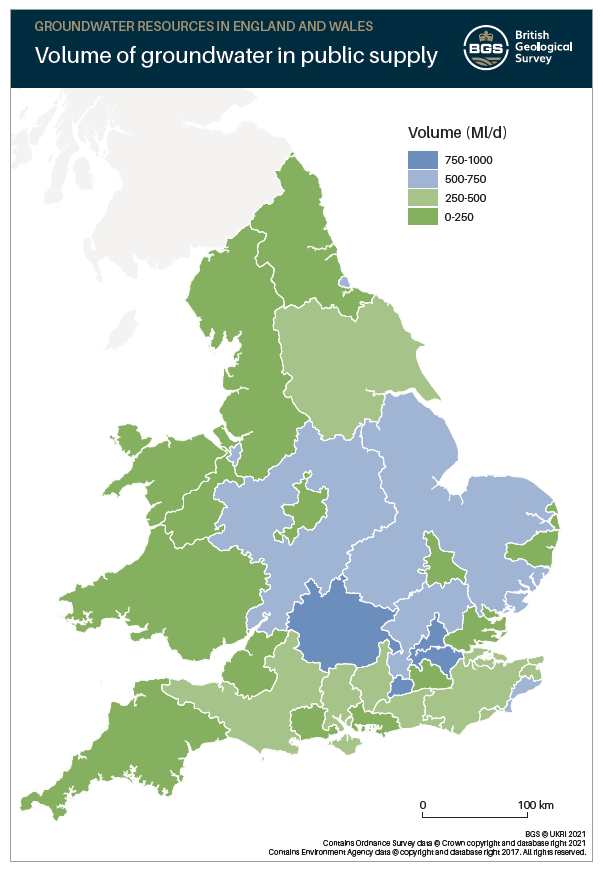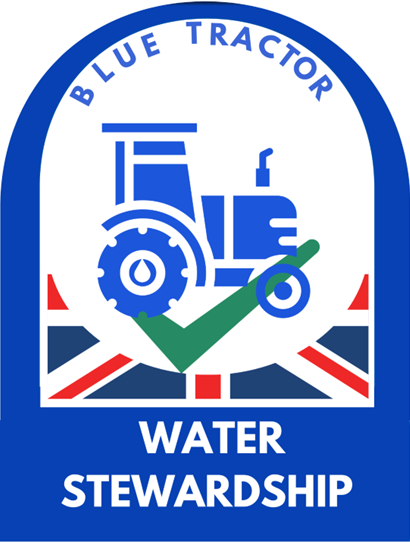Team 5B 2024: Blue Tractor scheme
The Question: How might we work with farmers to minimise water contamination?
With an increase in temperatures and more erratic weather patterns, large areas of the United Kingdom, especially in the South-East of England, are facing a future where water abstractions and deployable output will reach limits of sustainable water use. Especially in South-East England, over two thirds of the water supply are abstracted from groundwater. Water companies such as Anglian Water are looking into strategies for reducing abstractions and securing reservoirs and water storages for a long-term sustainable water supply.
One of the main problems, particularly in South-East England, is the sourcing of public water supply from groundwater aquifers with over two-thirds of the supply being pumped from ground water putting long-term water sustainability into jeopardy if aquifers get depleted beyond annual replenishment levels [1].

Figure 1: Volume of groundwater in public supply in the UK [2] (BGS ®UKRI).
Additional pressure on groundwater resources comes from agricultural activity. Water use reporting ranges between 14% [3] of total water abstractions to 1% [4] of water abstractions – these figures are highly dependent on farming region, agricultural activity, overall water availability and other uses. Water in agriculture is not only used for irrigation or water use for livestock which can consume a sizeable portion of water, but also fertilisers, manure and pesticides have a major impact on the usability of freshwater and can contaminate it [5].

Figure 2: Storyboard for Solution of Group 5B
The Solution: Sustainable water use label for agriculture

Figure 3: Suggestion of the introduction of an agricultural water stewardship label
Our group found that with the introduction of the Red Tractor Logo [6] many issues in British agriculture regarding overall environmental stewardship and animal welfare had been addressed, therefore the introduction of a voluntary agricultural water stewardship label was identified as a feasible option for tackling this particular aspect of future freshwater availability.
Just as prominent as the Red Tractor Label, the label would have to be standardised and requires checks by an external person with a set frequency of audits.
The areas that could be audited for good practice in agricultural water management are environmentally friendly irrigation, such as drip irrigation, or choice of cultivars that do not need extensive amounts of water. Other areas of good stewardship of water use could be the set-up of water meters for better water accounting options, as well as the installation of water recycling and filtering methods such as filtration tanks and membrane systems [7], [8].
Timeline
The scheme would be rolled out by creating preliminary set of areas that research has identified as major pathways of pollution or water sustainability loss and where water saving, water recycling or prevention of contamination could be achieved.
These themes will be discussed with farmers and other stakeholders in roundtable discussions.
Based on these discussions a pilot scheme could be rolled out which then returns new understanding of water saving and water pollution potential and the feasibility of the measures.
After the pilot project period, the scheme will be made available to additional farms step by step so that by 2035 the scheme will be available to all UK farmers.
Funding
The farming community should not be the only ones bearing the cost of auditing, licensing of the label as well as restructuring their farms and associated costs to water saving technologies. Therefore, this logo aims to also be accessible to low-income farmers.
For the initial pilot scheme, research grants and governmental grants will be applied for, to minimise the costs for farmers.
The pilot period also serves as a period of gaining consumer and retailer awareness of the logo. This is important in order to develop customer demand for products that were produced implementing good water use practices. Increasing consumer demand in turn will lead to pressure on retailers to incorporate the logo on products. Utilising the logo on packaging by retailers will require retailers to pay a logo licensing fee.
At the same time, farmers that do implement good water use practices will be able to request a certain additional amount of sales price for their products, incentivising them to subscribe to the label and pay a small fee for subscribing to the scheme to cover audits.
Additionally, UK Government funding is available for good agricultural water use practice [9], farmers subscribing to the scheme will be encouraged to apply for these types of support for funding the implementation of water saving and water preserving technologies.
Further implications for sustainable farming
With sufficient momentum from the farming community, but also wider stakeholders such as the surrounding municipalities, other water users, retailers and consumers, the scheme also aims to create a knowledge exchange network trying to support farmers to share their experiences on the road to improving good water stewardship practice.
References
[1] B. G. S. BGS, ‘Groundwater resources in the UK’, Groundwater resources in the UK. [Online]. Available: https://www.bgs.ac.uk/geology-projects/groundwater-research/groundwater-resources-in-the-uk/
[2] U. BGS, ‘Volume of Groundwater in Public Supply Infographic’, British Geological Survey, 2021. [Online]. Available: https://www.bgs.ac.uk/geology-projects/groundwater-research/groundwater-resources-in-the-uk/
[3] OECD, ‘Agriculture and Water Policies: Main Characteristics and Evolution from 2009 to 2019’, Water and agriculture. [Online]. Available: https://www.oecd.org/agriculture/topics/water-and-agriculture/documents/oecd-water-policies-country-note-united-kingdom.pdf
[4] DEFRA, ‘Water usage on farms: Results from the Farm Business Survey, England 2015/16’, Department for Environment, Food and Rural Affairs (DEFRA), National Statistics Publication, 2017.
[5] B. G. S. BGS, ‘The Impact of Agriculture’, British Geological Survey and Water Aid, Fact Sheet, 2009. [Online]. Available: https://www2.bgs.ac.uk/groundwater/downloads/themes_sheets/Agriculture2_1.pdf
[6] Assured Food Standards, ‘Red Tractor Logos’, Red Tractor Logos. [Online]. Available: https://redtractor.org.uk/our-logos/
[7] INTEWA GmbH, ‘Reuse of service water from small sewage treatment plants for agricultural irrigation’. [Online]. Available: https://www.intewa.com/en/company/press/article/reuse-of-service-water-from-small-sewage-treatment-plants-for-agricultural-irrigation/
[8] MANN+HUMMEL, ‘Membrane Bioreactors (MBRs)’, Membrane Bioreactors (MBRs). [Online]. Available: https://water-fluid-filtration.mann-hummel.com/en/products/water-wastewater-treatment/bio-cel-mbr.html
[9] Rural Payments Agency, ‘About the Water Management Grant Round 2, who can apply and what the grant can pay for’. Apr. 22, 2024.
